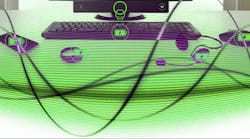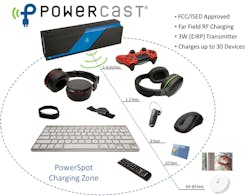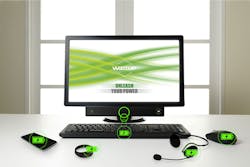While you were busy boxing up that ugly sweater Aunt Agnes gave you for Christmas, not one but two companies were announcing that the FCC had okayed their wireless power-at-a-distance charging solutions.
On Dec. 26th Powercast Corporation said that it will unveil at CES (booth #40268) an FCC- (Part 15) and ISED-approved (Innovation, Science, and Economic Development, Canada) three-watt PowerSpot transmitter which can deliver over-the-air charging to multiple electronic devices from a few inches to 80 ft. away, and that charging mats or direct line of sight are not needed.
Up until this point wireless charging has been very short range, based on either Qi or Powermat standards, where the device being charged generally must sit on a charging pad (and often at a very specific spot) that’s plugged into an outlet.
The Powercast PowerSpot transmitter, on the other hand, sends RF energy on the 915-MHz ISM band over the air to a receiver chip embedded in a device, which converts it to DC to recharge its batteries or directly power the device. This remote charging technology behaves like Wi-Fi, where enabled devices automatically charge when within range of a power transmitter.
1. The PowerSpot charging zone ranges from a few inches up to 80 ft.
Charging rates will vary with distance, type, and power consumption of a device. An Illuminated LED indicates devices are charging, and it turns off when they’re done. Audible alerts indicate when devices move in and out of the charging zone. The PowerSpot transmitter uses Direct Sequence Spread Spectrum (DSSS) modulation for power and Amplitude Shift Keying (ASK) modulation for data, and includes an integrated 6-dBi directional antenna with a 70-deg. beam pattern.
According to Powercast, power-hungry devices like game controllers, smart watches, and fitness bands will charge best up to 10 ft. away; low-power devices like home automation sensors (temperature, etc.) can be charged up to 80 ft. away. The company expects that up to 30 devices left in the zone on a countertop or desktop overnight can charge by morning, sharing the transmitter’s three-watt (EIRP) power output (Fig. 1).
Powercast’s Lifetime Power Energy Harvesting Development Kit for Battery Recharging is a demonstration and development platform for recharging batteries wirelessly from RF energy. It is designed to be used with an app and is configured for out-of-the-box operation. The battery recharging boards utilize the P1110B Powerharvester Receiver, which converts RF energy into DC power. Either the PowerSpot transmitter or TX91501-3W transmitter is the source of RF energy, with both operating at 915 MHz. Other RF energy sources operating from 850-950 MHz can also be used as power sources (UHF RFID readers, for example).
The kit includes a PowerSpot RF transmitter (with plastic mounting clips), a TX91501 transmitter, an RF energy harvesting evaluation board (P1110-EVB) with two antennas, a smartwatch shaped battery recharging board, a credit card-shaped battery recharging board, two coin cell (CR2032) -sized radio boards, and the necessary power adaptors.
The kit also includes two BLE radio boards that can be attached to the battery recharging boards. When used in conjunction with the watch or credit card battery recharging boards, the measured charge current and battery voltage are transmitted via Bluetooth to a mobile device and displayed in the included app. This enables the user to test both configurations on battery recharging boards simultaneously. The P1110-EVB is included in the kit, as well. It contains an evaluation board and antennas to test and develop with the P1110B Powerharvester Receiver. Like the Battery Recharge Boards, it converts RF energy into DC power which can be stored in a battery or capacitor, or else used to directly power a circuit. It includes two different antenna configurations.
Powercast will begin production of its standalone PowerSpot charger now that it is FCC-approved, and is also offering a PowerSpot subassembly to consumer goods manufacturers who want to integrate it into their own products (think lamps, appliances, set-top boxes, gaming systems, computer monitors, furniture or vehicle dashboards).
Also on December 26th, Energous Corp., the developer of WattUp charging technology, announced that it had received “Industry-First FCC Certification for Over-The-Air, Power-At-A-Distance Wireless Charging.” The FCC determined that the WattUp RF beam forming based wire-free at-a-distance charging is safe and meets the current regulatory health and safety guidelines established by the FDA (and enforced by the FCC).
The WattUp Mid Field transmitter sends focused, RF-based power to devices at a distance. The company claims it is the first FCC certification for power-at-a-distance wireless charging under Part 18 of the FCC’s rules; Part 18 rules permit higher-power operations than are permitted under the Part 15 rules that were used to approve Powercast’s at a distance charging devices.
WattUp can be applied to devices of greater or lower power, transmitting at distances of a few inches to 3 ft. or greater (Fig. 2). The WattUp system also is designed to charge devices at the point of contact as well as charge multiple devices at once, automatically charging devices as needed, until they are topped off. This “untethered, wire-free charging” can potentially enable charging a fitness band even while you are wearing it.
2. A WattUp transmitter sends energy via an RF)signal to WattUp-enabled electronic devices when requested. A WattUp receiver in each device converts that signal into battery power.
WattUp Mid Field and Far Field Transmitters sense and communicate to authorized receiver devices via Bluetooth Low Energy (BLE), only sending power when needed and requested by those devices. WattUp is software-controlled, determining which devices receive power, when, and in what priority. If there are no authorized devices within range, the WattUp transmitter becomes idle, and no power is wasted.
WattUp can use the 5.850 GHz-5.875 GHz band for the transmission of power for some Near Field, contact-based charging, such as for hearing aids.. This is just outside of the 5.8 GHz Wi-Fi band. But they have shifted their focus to 913-MHz frequency (transmission of power) for both WattUp Near Field and Mid Field charging solutions. Other technical specifications of the WattUp charging solution include:
- A GaN-based 5-10 W RF receiver IC
- A GaN-based 10-15 W RF power amplifier (PA)
- An RF-based charging solution allowing for full 2D / planar movement
- Support for 90-deg. charging angles (sideways charging)
- Accommodation of metal and other foreign objects
- PA integration into the overall system leading to a lowered BOM cost



